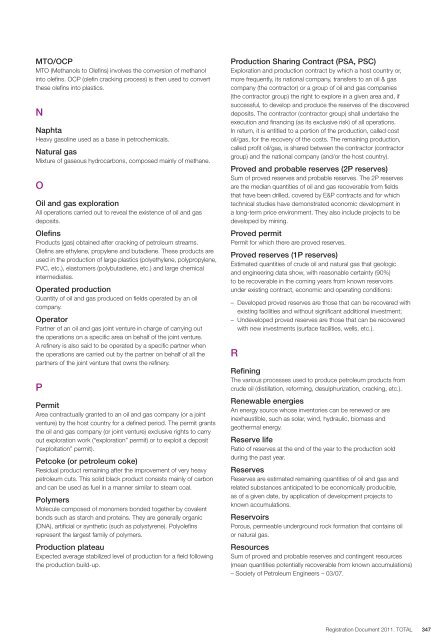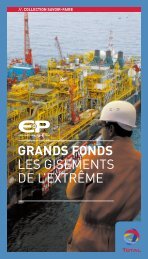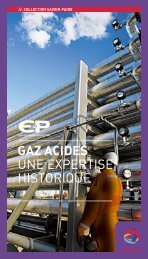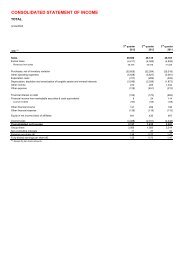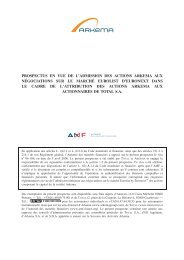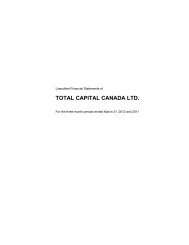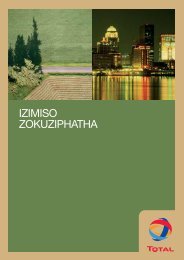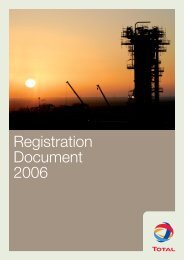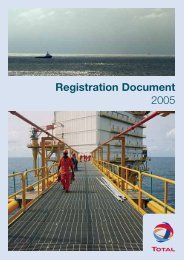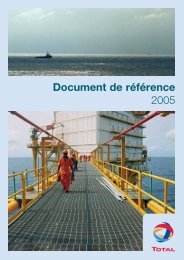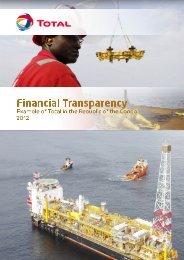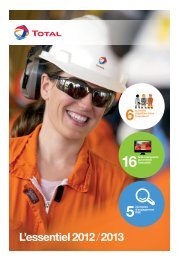Registration document 2011 - tota - Total.com
Registration document 2011 - tota - Total.com
Registration document 2011 - tota - Total.com
You also want an ePaper? Increase the reach of your titles
YUMPU automatically turns print PDFs into web optimized ePapers that Google loves.
MTO/OCP<br />
MTO (Methanols to Olefins) involves the conversion of methanol<br />
into olefins. OCP (olefin cracking process) is then used to convert<br />
these olefins into plastics.<br />
N<br />
Naphta<br />
Heavy gasoline used as a base in petrochemicals.<br />
Natural gas<br />
Mixture of gaseous hydrocarbons, <strong>com</strong>posed mainly of methane.<br />
O<br />
Oil and gas exploration<br />
All operations carried out to reveal the existence of oil and gas<br />
deposits.<br />
Olefins<br />
Products (gas) obtained after cracking of petroleum streams.<br />
Olefins are ethylene, propylene and butadiene. These products are<br />
used in the production of large plastics (polyethylene, polypropylene,<br />
PVC, etc.), elastomers (polybutadiene, etc.) and large chemical<br />
intermediates.<br />
Operated production<br />
Quantity of oil and gas produced on fields operated by an oil<br />
<strong>com</strong>pany.<br />
Operator<br />
Partner of an oil and gas joint venture in charge of carrying out<br />
the operations on a specific area on behalf of the joint venture.<br />
A refinery is also said to be operated by a specific partner when<br />
the operations are carried out by the partner on behalf of all the<br />
partners of the joint venture that owns the refinery.<br />
P<br />
Permit<br />
Area contractually granted to an oil and gas <strong>com</strong>pany (or a joint<br />
venture) by the host country for a defined period. The permit grants<br />
the oil and gas <strong>com</strong>pany (or joint venture) exclusive rights to carry<br />
out exploration work (“exploration” permit) or to exploit a deposit<br />
(“exploitation” permit).<br />
Petcoke (or petroleum coke)<br />
Residual product remaining after the improvement of very heavy<br />
petroleum cuts. This solid black product consists mainly of carbon<br />
and can be used as fuel in a manner similar to steam coal.<br />
Polymers<br />
Molecule <strong>com</strong>posed of monomers bonded together by covalent<br />
bonds such as starch and proteins. They are generally organic<br />
(DNA), artificial or synthetic (such as polystyrene). Polyolefins<br />
represent the largest family of polymers.<br />
Production plateau<br />
Expected average stabilized level of production for a field following<br />
the production build-up.<br />
Production Sharing Contract (PSA, PSC)<br />
Exploration and production contract by which a host country or,<br />
more frequently, its national <strong>com</strong>pany, transfers to an oil & gas<br />
<strong>com</strong>pany (the contractor) or a group of oil and gas <strong>com</strong>panies<br />
(the contractor group) the right to explore in a given area and, if<br />
successful, to develop and produce the reserves of the discovered<br />
deposits. The contractor (contractor group) shall undertake the<br />
execution and financing (as its exclusive risk) of all operations.<br />
In return, it is entitled to a portion of the production, called cost<br />
oil/gas, for the recovery of the costs. The remaining production,<br />
called profit oil/gas, is shared between the contractor (contractor<br />
group) and the national <strong>com</strong>pany (and/or the host country).<br />
Proved and probable reserves (2P reserves)<br />
Sum of proved reserves and probable reserves. The 2P reserves<br />
are the median quantities of oil and gas recoverable from fields<br />
that have been drilled, covered by E&P contracts and for which<br />
technical studies have demonstrated economic development in<br />
a long-term price environment. They also include projects to be<br />
developed by mining.<br />
Proved permit<br />
Permit for which there are proved reserves.<br />
Proved reserves (1P reserves)<br />
Estimated quantities of crude oil and natural gas that geologic<br />
and engineering data show, with reasonable certainty (90%)<br />
to be recoverable in the <strong>com</strong>ing years from known reservoirs<br />
under existing contract, economic and operating conditions:<br />
– Developed proved reserves are those that can be recovered with<br />
existing facilities and without significant additional investment;<br />
– Undeveloped proved reserves are those that can be recovered<br />
with new investments (surface facilities, wells, etc.).<br />
R<br />
Refining<br />
The various processes used to produce petroleum products from<br />
crude oil (distillation, reforming, desulphurization, cracking, etc.).<br />
Renewable energies<br />
An energy source whose inventories can be renewed or are<br />
inexhaustible, such as solar, wind, hydraulic, biomass and<br />
geothermal energy.<br />
Reserve life<br />
Ratio of reserves at the end of the year to the production sold<br />
during the past year.<br />
Reserves<br />
Reserves are estimated remaining quantities of oil and gas and<br />
related substances anticipated to be economically producible,<br />
as of a given date, by application of development projects to<br />
known accumulations.<br />
Reservoirs<br />
Porous, permeable underground rock formation that contains oil<br />
or natural gas.<br />
Resources<br />
Sum of proved and probable reserves and contingent resources<br />
(mean quantities potentially recoverable from known accumulations)<br />
– Society of Petroleum Engineers – 03/07.<br />
<strong>Registration</strong> Document <strong>2011</strong>. TOTAL 347


